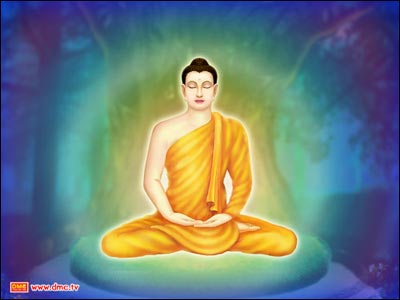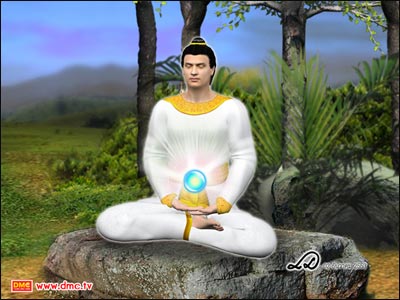Dhammacakkapavattana Sutta
for Pursuers of Perfection # 1
Dhammacakkapavattana Sutta for Pursuers of Perfection
1. Introduction
In this Appendix we delve al little deeper into the meaning of the Dhammacakkapavattana Sutta. The Dhaamacakkapavattana Sutta itself is a very brief teaching because it serves merely as a reminder to listeners who were already well versed in the materials covered. However, for us reading the Dhammacakkapavattana Sutta in the ignorance of the present day, at face value, it is a little too difficult for us immediately to understand.
2. What is the Dhammacakka?
At face value, the Dhammacakka is a wheel of the Dhamma and traditionally speaking, it was just considered as a metaphor for the means by which the Dhamma could make progress or go forth. However, the present author is of the opinion that to make the Dhamma into a Dhammacakka is a way of comparing it to the ‘jewelled wheel’ of a Universal Monarch. You may already have seen from th Cakkavatti Sutta that in any world era when there is no Buddha arising in the world, there will be a Universal Monarch who rules in justice over the world. The Universal Monarch keeps Five Precepts on ordinary days and Eight Precepts on the Uposatha Days (full-moon and new moon days). The Universal Monarch is endowed with seven forms of jewels by which he can rule the world:
1. A jeweled wheel;
2. A jeweled elephant;
3. A jeweled horse;
4. A jeweled general;
5. A jeweled treasurer;
6. A jeweled lady;
7. Precious stones.
Most important amongst these endowments is the jeweled wheel [cakka] which arises through the strength of the Universal Monarch’s own merit. The Jewelled Wheel has two special characteristics it is:
1. An invincible weapon: if the owner ever needs to deal forcibly with any evils such as organized crime, all he needs to do is make a presolution in his mind and the Jewelled Wheel will lead his troops to quell the troubles – and no other weapon will be able to defeat them. The jeweled wheel is like a weapon at the forefront of technology – however, unlike the best of technology known today, the owner doesn’t even need to press a button all he needs to do is to make a resplve to himself, The Jewelled Wheel will turn to the left or the right in accordance with the owner’s every intention.
he Dhamma of the Lord Buddha, like the Jewelled Wheel of
the Universal Monarch can serve as both a weapon and a vehicle
2. A vehicle: if the owner or his community ever need to be transported to a distant place or to cross difficult territory such as deserts or mountains, then they can do this by virtue of the Jewelled Wheel – flying through the air if necessary. In descriptions of Universal Monarchs of the past, the Jewelled Wheel has often been used to transport the community from one continent to another or even one world to another. In the time of the Buddha, the scriptures report that people and the Universal Monarch were transported from another continent called Uttarakurudipa (to the North of Mount Sumeru) to the human world of Jambudipa (to the South of Mount Sumeru) by means of the Jewelled Wheel of that Universal Monarch. However, the Universal Monarch passed away during their visit and the Jewelled Wheel disappeared with him, making the community unable to return. Thus they resigned themselves to living in the human realm, establishing their own territory called “Kururattha”. Usually those from the Uttarakurudipa are always strictly established in the Precepts, but after the passing of many generations, a war broke out amongst the kuru people themselves as is recorded in the Mahabharata called the ‘Bharatayuddha’. These are the traces left behind of beings from another continent (effectively from another planet or another universe). Kuru of those times is in the same location as New Delhi of the present day.
The Dhamma of the Lord Buddha, like the Jewelled Wheel of the Universal Monarch can serve as both a weapon and a vehicle:
1. The Dhamma as a Weapon: The Dhamma can be considered like a weapon, because it allows us to execute the defilements-or the three forms of craving: craving for the sensual realm, for the form plane and for the formless plane.
2. The Dhamma as a Vehicle: The Dhamma cats like a vehicle in transporting us out of the Cycle of Existence [vadda-samara] on the levels of the Sensual Plane, the Form Plane and the Formless Plane so that we can enter upon Nirvana.
Thus in the inauguration of the Dhamma to the world, these two reasons are ample explanation for why this first Sutta should be called the Dhammacakkapavattana Sutta. There fore, the Dhammacakkapavattana Sutta can be said to be a teaching about the Power of the Dhamma – which can be compared to the power of the Jewelled Wheel of a Universal Monarch. It is not that other Dhamma teachings by the Buddha do not have comparable importance – but the dhammacakkapavattana Sutta was the first and the teachings which came later only serve to expand upon the foundations already laid down in this inaugural Sutta.
them to attain enlightenment in their meditation with uncommon ease.
The Buddha taught the Dhammacakkapavattana Sutta on the full-moon day of the eighth lunar month, two months after His Enlightenment. He gave the sermon at the Isipatana Deer Park near Benares. This woodland was a haunt of ascetics and also a natural sanctuary set up by royal decree no-one was allowed to hunt any of the animals which lived there. In ancient India, even though the king who made the degree might pass away, or even if his dynasty might fakk, the decree would live on out of hereditary respect that all the castes had for the kingly caste.
The Dhammacakkapavattana Sutta was taught to the Group of Five {pancavaggiya} ascetics who had Kondanna as their leader. To understand how the Dhammacakka-pavattana Sutta could have given the result it did on these five ascetics, it is important to know a little of their backgrounds first. Unfortunately, in many buddehist countries of the world, there is the misunderstanding that Enlightenment can be achieved without training oneself in meditation. Such people cite examples of enlightenment such as that of Bahiya Daruciriya who, in his final lifetime didn’t appear to meditate, but could become enlightened just by hearing a few words from the Buddha at the roadside. Therefore, they come to the conclusion that meditation is unnecessary for enlightenment and that there is no necessity for themselves to practice meditation. What they fail to take into account is the influence of his previous lifetimes. It turns out that in a previous lifetime:
Bahiya was one amongst a group of monks who climbed up onto a mountain plateau and vowed to themselves not to leave the mountain until they could attain enlightenment or at least fly down in the air by their own mental powers. After three days of meditation. One of the group became an arahant – he promised to bring food back from his almsround for the others, but they refused to eat it. On the fifth day, another monk became enlightened at the level of “non-returner” became enlightened at the level of “non-returner” and he went for almsround too, but again, the others refused to eat his almsfood. After the passing of seven days, the remainder of the group died of starvation.
They had effectively meditated to death, but the habit of earnest, to sacrifice even one’s own life in meditation, carried over into subsequent lifetimes allowing them to attain enlightenment in their meditation with uncommon ease. Tappa-mallaputta was able to attain Arahantship from the age of seven. Bahiya had also been one of the group. The Buddha gave Bahiya only a very short sermon:
“Seeing only, hearing only, smelling only, tasting only, coming in physical contact only –for all things just sensing.” With those words alone, Bahiya was able to become an arahant. However, there are those, both in Thailand and abroad who look at examples such as that of Bahiya and come to the conclusion that you don’t need to meditate in order to attain enlightenment.
meditation
Therefore, for the Dhammacakkapavattana Sutta, it is necessary to give a few words of explanation about the meditational backgrounds of the ‘group of five’.
If you look into the history of Kondanna, you find that he has an extraordinary history. Even in this final lifetime of his, when he was a young man, he had completed his studies of all eighteen academic schools. According to the commentary Pathamasambodhigatha he was the leader of Kapilavastu’s envoy to Devadaha to ask the hand of Queen Maha Maya for marriage to King Suddhodana. After the birth of Prince Siddhattha, Kondanna was the amongst the soothsayers selected to deliberate the vital signs of the new born prince – and amongst the soothsayers he was the most precise, giving one possibility alone for the vocation of the prince, whereas all the other soothsayers gave two possibilities. According to Kondanna, there was no way the prince could follow the vocation of a Universal Monarch – the only possibility for him was to become the world spiritual leader. After having seen the vital signs of Prince Siddhattha, from that day forth Kondanna was to prepare himself spiritually, awaiting the day when the prince would renounce his worldly life. When at the age of twenty-nine, Prince Siddhattha renounced the palace, Kondanna was the first to ordain in his footsteps. Thus, Kondanna had at least twenty – nine years of experience in spiritual and academic study under his belt by the time he renounced the world in Siddhattha’s footsteps. When Siddhattha was training himself under the auspices of Alara and Udaka it was Kondanna who was also to train himself in Siddhattha’s footsteps. Thus, Kondanna, along with his other four companions were all adept in meditation by the time they came to hear the dhammacakkapavattana Sutta.
And again we owe it to the thoroughness of Ananda from the introduction given not just to the Dhammacakkapavattana Suttha, but to most of the Buddha’s teachings, that we know exactly where, to whom, when and with what result that teaching was given. From Ananda’s example, we can learn principles of recording noter on and with what result that teaching was given. From Ananda’s wxample, we can learn principles of recording notes on any activity that we must always be able to write down “what” it is about, “when” it was done, “where” it happened, “to whom” it happened and “the effect” it had.
Thus, the Dhammacakkapavattana Sutta was given for the benefit of the ‘group of five’ who would have been some of the foremost meditation adepts of the day. They were of a quality that was recognized by kings, courtiers and philosophers alike.
Meditation - Related Articles
" />
" />
" />
" />
" />
" />
" />
" />
" />
" />
" />
" />









